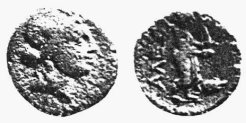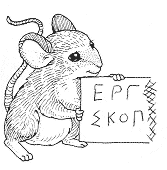Dear Professor Fleischer! It is a pleasure to have this opportunity to honor your achievements and to thank you for many kindnesses over many years. Since some of our work as colleagues involved editorial projects, I hope that you will accept an aparche harvested by the blue pencil rather than by the word processor. The editors of the present volume entrusted me with the preparation of the following contribution, which was submitted anonymously.
The writer of the essay that lies before you remains unknown. As no work published during the past twenty-odd years seems to be cited, despite the author's obvious enthusiasm for the subject, we must admit the sad possibility that the manuscript was sent by some friend or relative on behalf of a long-deceased scholar. All inquiries to some dozens of colleagues having met with the most vehement denials of any knowledge whatsoever of writer or work, it has proved impossible to determine the identity of the author. I give here the original text, documentary apparatus, and illustrations; such editorial supplements as seemed appropriate appear in brackets.
The Symbolon of Apollo Smintheus
One of the unsolved problems in the history of Greek sculpture is the image of Apollo Smintheus in Chryse, in the Troad. The evidence for this statue includes both detailed literary accounts and (it has been claimed) representations on coins, as well as information from the excavation of the sanctuary. But there are inconsistencies in this evidence, and no convincing synthesis of the various sources has been reached. I shall concentrate here on the form and placement of the symbolon. The chief evidence for the statue consists of two literary passages. The earlier of these is Strabo XIII.1.48 C 604:
ἐν δέ τῇ Χρύσῃ ταύτῃ καὶ τὸ τοῦ Σμιθέως Ἀπόλλονος ἐστιν ἱερόν, καὶ τὸ σύμβολον τὸ τὴν ἐτυμότητα τοῦ ονόματος σῶζον, ὁ μῦς, ὑπόκειται τῷ ποδὶ τοῦ ξοάνου. Σκόπα δʹἐστὶν ἔργα τοῦ Παρίου. σψνοικειοῦσι δὲ καὶ τὴν ἱστορίαν εἴτε μῦθον τούτῳ τῷ τόπῳ τὴν περὶ τῶν μυῶν.
In this Chryse is also the sanctuary of Sminthian Apollo, and the symbolon that preserves the etymology of the name, the mus, lies under the foot of the wooden statue. They are the works of Scopas of Paros; and also the history or myth about the mues is associated with this place.
Strabo then tells a number of stories concerning the mues. The one directly relevant to the statue is this:
Ἡρακλείδης δʹ ὁ Ποντικὸς πληθύοντάς φησι τοὺς μύας περὶ τὸ ἱερὸν νομισθῆναι τε ἱεροῦς καὶ τὸ ξόανον οὕτω κατασκευασθῆναι βεβηκῶς ἐπὶ τὸ μυί.
Heraclides of Pontus says that the mues that are numerous in the sanctuary are also considered sacred and that therefore the wooden statue is made standing on a mus. (1)
Eustathius, the latest authority (A.D. XII) on the statue, clearly depends directly on Strabo:
φησὶ γὰρ ἡ ἱστορία, ὅτι ἐν τῇ Χρύσῃ Σμιθέως ἐστὶν ἱερὸν καὶ μῦς ὑπόκειται τῷ ποδὶ τοῦ ξοάνου, Σκόπα ἔργον τοῦ Παρίου, τὸ σύμβολον τὸ τὴν ἐτυμότητα σῷζον τοῦ ὀνόματος, ἤγουν ἐν ᾧ κεῖται ἡ τοῦ Σμινθέως ἐτυμολογία.
For the history says that in Chryse there is a sanctuary of Smintheus, and under the foot of the wooden image lies a mus, the work of Scopas of Paros, the symbolon that keeps alive the etymological meaning of the name; that is to say, in which the etymology of Smintheus lies. (2)
The statue is also mentioned by Menander Rhetor (A.D. III/IV), but the passage in which it appears is manifestly nothing more than a demonstration to a student of how to adapt stock rhetorical themes to a patron's special order. No description of the image is given, and the minimal (indeed, the only) documentary value of the passage lies in the confirmation of the local fame of the statue. (3)
It is generally thought that the xoanon is to be identified with the statue that appears first on coins of Hamaxitus and, after the relocation of the inhabitants of that city, on those of Alexandreia Troas: "Apollo Smintheus, in himation, with quiver at shoulder, standing r.; in outstretched r., patera; in l., bow; in front, at his feet, mouse." (4) The identification has been doubted. (5) The statue depicted on the coins does not match Strabo's description, for no mus lies beneath its foot, and it does not resemble the works of Scopas that have been identified. (6) (Figure 1)
 |
 |
| Figure 1: Bronze coin of Alexandreia Troas; drawing of emblem. | |
Several explanations for these discrepancies have been offered. In 1932, V. Grace argued that in terms of grammar, the erga of Scopas in Strabo's passage are better found in the hieron and the symbolon than in the genitive xoanou. (7) In that case, not the xoanon, but only the mus would be the work of Scopas. Another possibility is that the statue is a deliberately archaizing work. Of the scholars who have adopted this view, P. Lehmann has gone furthest in arguing for an archaizing element in the œuvre of Scopas. (8) This idea has the merit of making Scopas a sculptor of men, not mues, but it leaves unanswered the major questions: Where was the mus? Why is it not shown under the foot of the statue? Lehmann proposes that "the mouse may have been omitted because of the impossibility of making this small creature visible and intelligible". (9) Others have suggested, without success, that the mus was hidden by the base of the statue or held in its hand. (10) But this does not give the mus its due. In the eyes of our sources, the mus was the only memorable feature of the statue. It cannot be ignored or wished away.
Lehmann also makes the suggestion that the symbolon, which is stated by all the sources who mention it to lie beneath (the foot of) Apollo, but which appears in the coins only as a free emblem in the pictorial field (when it appears at all), was carved in relief on the base of the statue. The coins she adduces, however, clearly show a garlanded but otherwise perfectly plain pedestal. (11)
All these ingenious arguments are founded on one basic error. It is assumed that the literary sources all refer to the statue shown on the coins. I wish to suggest that in fact two different statues are in question.
Eustathius obviously depends on Strabo and Strabo alone, and so cannot be considered an independent authority. Strabo himself was no traveller; there is no evidence that he ever set foot in the Troad, and some to suggest that he did not. (12) His knowledge of the statue probably came only from literary sources. His own text clearly shows that all his information regarding the appearance of the statue came from Heraclides, the philosopher from Heracleia Pontica and contemporary of Scopas (IV B.C.). It is likely that the Apollo by Scopas is not the Apollo referred to by Heraclides, but instead that Strabo applied Heraclides' remarks to the statue by Scopas, which he had never seen, but knew from other sources.
There is an important difference between Strabo's description and that by Heraclides as quoted by Strabo. Strabo says that ὁ μῦς ὑπόκειται τῷ ποδὶ τοῦ ξοάνου, while according to Heraclides, τὸ ξόανον κατασκευασθῆναι ἐπὶ τῷ μυί.
The idea that the mus lay beneath the foot of the statue is Strabo's own interpretation of Heraclides' words, perhaps influenced by the popular "Jason" type of male figure standing with one foot raised on a support, which had gained popularity in Hellenistic times. (13) But to place a mus under the foot of Apollo in this or any such pose would produce a ridiculous image.
Heraclides was neither an antiquarian nor a traveller. He will have mentioned the statue because it was relevant to his discussion in this case, of the story of the mues in the sanctuary. (14) His interest was focused on the mus itself, and the symbolon was the salient feature of the image. He does not even mention Scopas. I suggest therefore that while the coins may show the image made by Scopas and mentioned by Strabo, it is not the image mentioned by Heraclides. Strabo attempted to apply Heraclides' description to a statue that he had not seen. The emblem on the coins may be related to the image of a mus beside the tripod that is mentioned by Aelian (Nat.an. 12.5 [Ricl (n. 1, 193, T 16]), but it is not relevant to the statue mentioned by Heraclides.